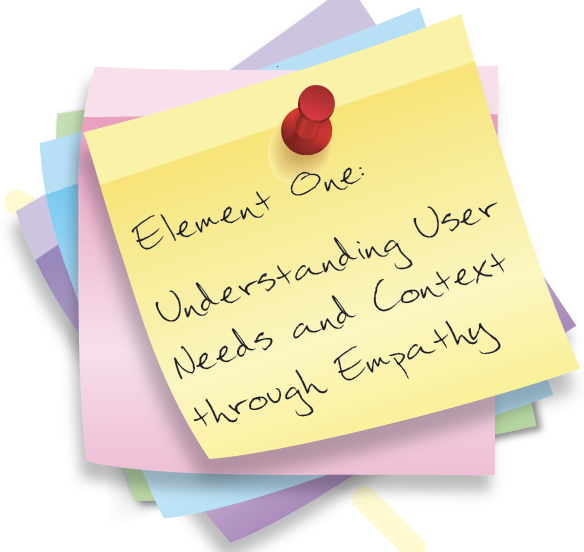
Element One: Understanding User Needs and Context through Empathy
Five Core Elements of Design Thinking and their Impacts
Our research into design thinking across multiple organizations employing an array of models suggests five elements integral to design thinking in action. Fundamental to all design thinking approaches is the aim to develop a deepened understanding of stakeholders’ contexts, particularly those of the user or citizen for which any service is being designed. This emphasis on decision-makers experiencing a profound and personal, almost sensory, immersion into the subjective realities of individual stakeholders may be the key differentiator between design thinking and other approaches like The Lean Startup. By focusing on developing empathy for stakeholders through the use of ethnographic tools, design thinking teams reframe problem definitions and generate possible solutions based on derived insights into customers’ actual behavior; not what they say they will do, what they actually do. Those tools include ethnographic observation and interviewing, journey mapping, analysis of user “jobs (both practical and psychological) to be done” and the creation of personas that illustrate different categories of users and their needs.
Rather than relying solely on quantitative data, such as surveys and market analyses, human-centered design involves being deeply interested in the details of human lives and, therefore, innovation team members seek first-hand and empathetic connections. Often, this involves using co-creation approaches that invite these stakeholders into the conversation itself. In other instances, stakeholder perspectives are introduced by members of innovation teams who rely on ethnographic research. Ideally, this pursuit of deeper insights into unmet, and often unarticulated, needs precedes the search for solutions. In fact, much of DESIGN THINKING’s unique value derives from holding solution-oriented decision-makers in the problem space long enough to reframe their challenge definition in ways that generate the possibility of more creative solutions through more profound understandings of human, primarily user, behaviors.
The development of a deep empathic consideration of stakeholders impacts the innovation process in multiple ways: by providing user-driven criteria for ideation and encouraging reframing of the problem to improve solution quality; by helping align team members’ perspectives; and by building emotional engagement throughout an organization which increases the likelihood of successful implementation. Finally, this empathic base also enhances teams’ abilities to alter course and pivot with agility because of its focus on understanding user needs rather than designing particular products, allowing the design criteria created to be deployed across a variety of products as needs and technologies change.




